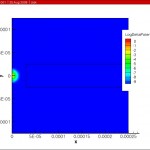As a follow up to the previous post, here are the results when 3d versions of the structures were created. The active areas are in the center of the device, and the rest of the device are translucent.
Category Archives: DEVSIM
Biosensor Applications in DEVSIM
I became interested in replicating the results in this paper:
Y. Liu, J. Sauer, and R. Dutton, “Effect of electro-diffusion current flow on electrostatic screening in aqueous pores,” Journal of Applied Physics, Vol. 103, p.084701, 2008
which Dr. Liu provides on his website here:
http://www-tcad.stanford.edu/~yangliu/
The two plots in this post reflect the effect of a charged macro molecule (e.g. DNA) under biased and unbiased conditions in the structure. The structure has contacts at the top and bottom. The plots for a bias of 0 and 7 volts are included in this post. The plots show the potential difference when the charged macro molecule is present and not present in the aqueous pore to the center left of the picture. More information about the significance of the result may be found in Dr. Liu’s paper.
In order to replicate Dr. Liu’s results, the cylindrical coordinate system was implemented in DEVSIM. The device is cylindrical and the structure is wrapped around the left vertical axis. The PDE’s for the potential and flux densities were implemented in a fashion similar to the standard drift diffusion formalism for TCAD simulation.
- ve0
- ve7
Porting DEVSIM to Windows
While our primary development platform is 64-bit Linux, work is in process to get DEVSIM working on 32-bit Windows. It has been challenging, but thankfully the porting process has become easier as compiler vendors have become more standards compliant. It is especially nice that the majority of the third party components of our software already support Windows and Unix-like platforms.
One of the benefits of porting with a new compiler has been to identify code which is not necessarily portable across computer architectures, or entirely C++ standards compliant. This effort has even enabled us to find a few minor defects in our implementation.
I am happy to report that we have a functioning build on Windows, and thorough regression testing is in progress.
Capacitance Simulation
This is a simulation of a single conductor above a ground plane. The simulation window is actually much larger to ensure proper boundary conditions.

Solving for magnetic fields in DEVSIM.
This past week I’ve been experimenting with solving magnetic field problems. Here is my first result. Two wires are in the center of the figure with current flowing in opposite directions. The solution variable is the magnetic vector potential, A, and is shown in the color gradient. The arrows are the magnetic field, B, which is post processed from the solution. In turns out this post processing is similar to finding the vector impedance field used in noise analysis.

Sensitivity Analysis White Paper
A new white paper concerning sensitivity analysis is available here:
TCAD Sensitivity Analysis for Device Optimization
New White Paper
I have uploaded a white paper to the website. It discusses some of the concepts behind DEVSIM.
Symbolic Model Evaluation for TCAD Device Simulation
Writing documentation
Nothing more fun than writing documentation. Of course, no one can use your software if you don’t provide instructions. Contrary to what many software developers believe, providing an example is not the same as providing documentation.
3d MOSFET
gmsh for 2d mosfet
 Here is a 2d mosfet meshed with Gmsh and loaded into DEVSIM. Note that this is the same structure and doping which was originally shown here in my first post.
Here is a 2d mosfet meshed with Gmsh and loaded into DEVSIM. Note that this is the same structure and doping which was originally shown here in my first post.
It just looks a lot better having used a nicer meshing tool than the one built into the software.
As before, the red areas are the electron concentration.




